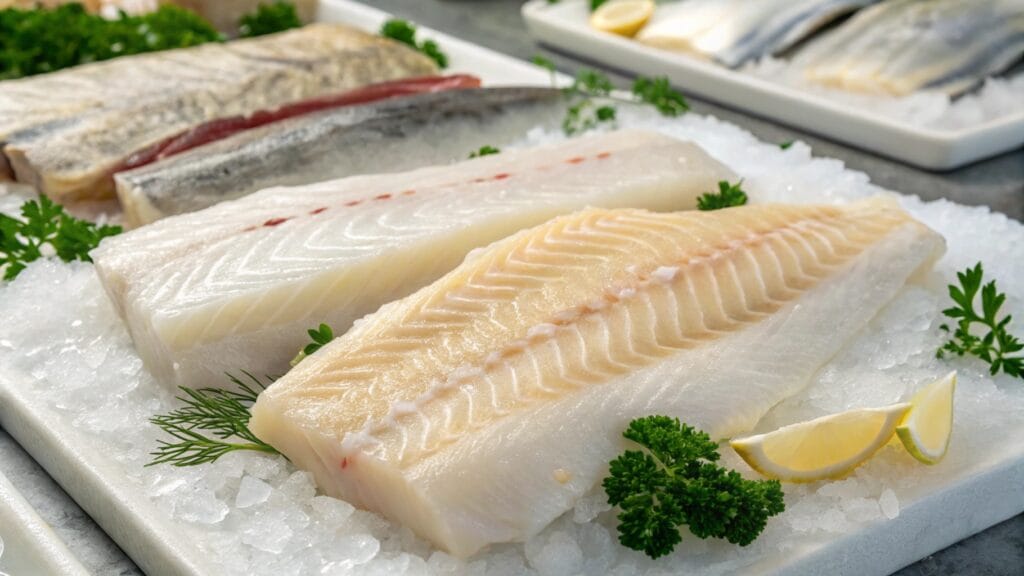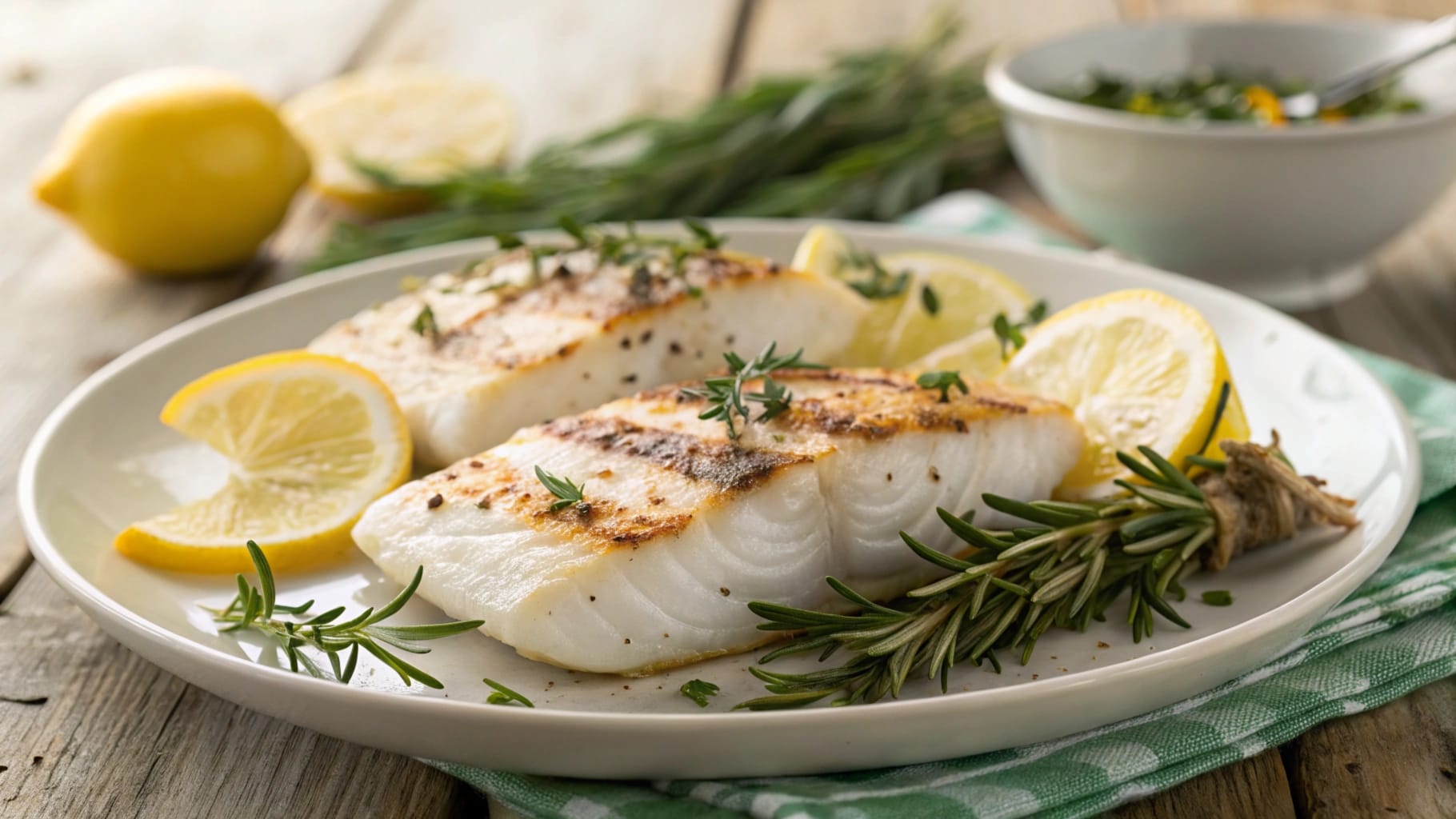What is White Fish? An Introduction
lean fish is a popular seafood choice found in kitchens and restaurants around the world. But what exactly is lean fish? Well, white fish refers to a broad category of fish species that have lean, white flesh—unlike fatty fish like salmon or mackerel, which have darker meat. White fish typically has a mild flavor and flaky texture, making it versatile and easy to cook in many different dishes.
You’ve probably heard of common lean fish like cod, haddock, and pollock, but there’s much more to this group than meets the eye! These fish are often praised for their health benefits, delicate flavor, and the fact that they are lower in fat compared to other seafood.
But beyond just their taste, lean fish has nutritional properties that make it a popular choice for anyone looking to eat healthier. It’s also a fantastic source of lean protein, making it a great addition to many diets.
Defining White Fish: Characteristics and Nutritional Value
lean fish are typically found in colder waters and have a “white” or pale flesh, which is lower in fat content than other types of fish. This makes them a preferred choice for anyone trying to eat lighter, healthier meals without sacrificing flavor.
Here’s a quick overview of the nutritional value of lean fish:
| Nutrient | Amount per 3.5 oz (100g) of Cod |
|---|---|
| Calories | 105 kcal |
| Protein | 20g |
| Fat | 1g |
| Carbohydrates | 0g |
| Omega-3 | 200mg |
| Vitamin B12 | 2.4mcg |
| Sodium | 90mg |
As you can see, lean fish like cod offers a low-calorie, high-protein option. Plus, it’s packed with important nutrients like Vitamin B12 (great for energy), Omega-3 fatty acids (which support brain and heart health), and very little fat.
But here’s the kicker—lean fish is also an excellent source of lean protein. This makes it a perfect food choice for people trying to maintain or build muscle, or even for those looking to lose weight without giving up delicious meals.
Types of White Fish: Popular Varieties Around the World
When it comes to lean fish, you’ll be spoiled for choice. From mild to slightly sweet flavors, lean fish species vary, but all of them have one thing in common: their tender, flaky texture. Here are a few of the most popular varieties:
Cod: A Classic Choice for Fish Lovers
Cod is probably the most well-known lean fish, especially in dishes like fish and chips or cod fillets. It’s mild in flavor, which makes it an excellent choice for people who don’t like the strong taste of fish. Cod is perfect for grilling, baking, or frying and is often available fresh, frozen, or in fillet form.
Haddock: Versatile and Flavorful
Haddock is another classic mild fish that’s often used in British and American cuisines. It’s known for its slightly sweet taste and firm texture, making it ideal for a variety of cooking methods. It’s often smoked to create smoked haddock, which is a delicacy in many regions.
Pollock: The Sustainable Seafood Option
Pollock is a very popular fish, particularly in the fast food industry. You’ve probably eaten it in fish sticks or McDonald’s Filet-O-Fish. Pollock is also a more sustainable seafood choice, making it an eco-friendly option. This fish is versatile and can be baked, grilled, or used in soups and stews.
Halibut: A Premium White Fish for Special Occasions
If you’re looking for something a bit more upscale, halibut is the fish for you. This large, flat fish has a firm texture and a slightly sweet flavor. It’s perfect for grilling or searing and is often featured in gourmet recipes. Halibut is a higher-end mild fish, so it’s often saved for special occasions or when you’re treating yourself to something extra delicious.
Health Benefits of White Fish
mild fish is often hailed as a superfood because of its high nutritional value. Whether you’re trying to maintain a healthy weight, increase your protein intake, or just enjoy a delicious meal, mild fish is a fantastic option. Let’s take a closer look at the health benefits of this fish.
High in Protein: A Lean Source for a Healthy Diet
One of the key benefits of mild fish is its high protein content. Protein is essential for building and repairing tissues, and it’s also a crucial part of your immune system, enzymes, and hormones. Unlike red meats, mild fish is a lean protein, meaning it doesn’t come with the same amount of fat. This makes it a great option if you’re looking to build muscle or maintain a healthy weight.
For example, a 100-gram portion of cod provides a whopping 20g of protein, which is about the same amount of protein you’d find in a serving of chicken breast!
Rich in Omega-3 Fatty Acids: Promoting Heart Health
While white fish may not be as rich in Omega-3s as oily fish like salmon, it still provides a healthy dose of these essential fatty acids. Omega-3s are essential for maintaining good heart health and can help reduce inflammation in the body. These healthy fats can also promote better brain function and protect against cognitive decline as you age.
Packed with Essential Vitamins and Minerals
In addition to protein and Omega-3s, white fish is a good source of essential vitamins and minerals that are important for overall health. Vitamin B12, for instance, plays a major role in energy production and the formation of red blood cells. White fish also provides selenium, an antioxidant that helps protect cells from damage, and niacin (Vitamin B3), which supports the digestive and nervous systems.
Block Quote:
“White fish is an affordable, healthy, and tasty source of lean protein that fits well into a balanced diet.” – Health Expert
How to Cook White Fish: Delicious and Easy Recipes
Cooking white fish can be a fun and rewarding experience. Whether you’re a beginner in the kitchen or a seasoned cook, there are plenty of ways to prepare white fish to suit your taste. The best part? It’s quick and easy to make! Let’s take a look at some of the best methods for cooking white fish.
Baking, Grilling, or Frying: Which Method is Best?
When it comes to cooking white fish, there are several methods you can use, depending on the type of fish and your preferred taste:
- Baking: This is a great way to cook white fish if you want a low-effort, healthy meal. Simply season your fish with herbs, spices, and a drizzle of olive oil, then bake it in the oven for 10-15 minutes (depending on thickness). This method helps retain the fish’s moisture, making it tender and juicy.
- Grilling: If you’re craving a smoky flavor, grilling is an excellent choice. Grilled white fish takes on a wonderful charred taste, which adds depth to the flavor. Just make sure the grill is hot, and the fish is well-oiled to avoid sticking.
- Frying: For those who enjoy a crispy, crunchy texture, frying white fish is a favorite method. You can make a light batter or breading and fry the fish until golden brown. While frying adds a bit of fat, it’s a delicious option when you want something indulgent.
Simple and Tasty White Fish Recipes for Beginners
If you’re new to cooking white fish, here’s a simple recipe you can try:
Lemon Herb Baked Cod
Ingredients:

- 2 cod fillets
- 1 tablespoon olive oil
- 1 teaspoon garlic powder
- 1 teaspoon dried thyme
- 1 lemon (zested and juiced)
- Salt and pepper to taste
Instructions:
- Preheat your oven to 375°F (190°C).
- Place the cod fillets on a baking sheet lined with parchment paper.
- Drizzle the fillets with olive oil and sprinkle with garlic powder, thyme, salt, and pepper.
- Zest and juice the lemon, and pour it over the fillets.
- Bake for 10-12 minutes or until the fish flakes easily with a fork.
This recipe is simple, healthy, and packed with flavor, making it a perfect introduction to cooking white fish.

How to Choose the Best White Fish: Freshness and Sustainability
Choosing the right white fish is essential for making sure your meals are delicious and healthy. Whether you’re shopping at the local fish market or your grocery store, knowing what to look for will ensure that you’re getting the best quality. Here’s how you can make the right choice when buying white fish.
Tips for Selecting Fresh White Fish at the Market
When buying white fish, freshness is key to getting the best taste and texture. Here are some simple tips to help you choose the freshest fish:
- Look at the eyes: Fresh fish should have clear, bright eyes. If the eyes are cloudy or sunken, the fish is likely old.
- Check the smell: Fresh fish should have a clean, ocean-like smell. If it smells overly fishy or sour, it’s best to pass on it.
- Firm flesh: Gently press the fish with your finger—fresh fish should bounce back and feel firm. If it leaves an indentation or feels soft, it may not be fresh.
- Bright gills: The gills of fresh fish should be a bright red or pink color. Brown or dull gills are a sign that the fish has been stored for too long.
- Packaging matters: If you’re buying packaged fish, make sure there’s no excessive ice or moisture in the package. Excess water can affect the fish’s flavor and texture.
Understanding Sustainability and Eco-Friendly Choices
Sustainability is an important factor to consider when buying seafood. Overfishing and unsustainable fishing practices can harm marine ecosystems and deplete fish populations. Here’s how to make eco-friendly choices when purchasing white fish:
- Look for certifications: Marine Stewardship Council (MSC) or Aquaculture Stewardship Council (ASC) certified fish are good choices. These labels indicate that the fish was sourced sustainably.
- Research local options: Choosing fish caught near your area can help support local, sustainable fisheries and reduce the carbon footprint associated with transporting seafood.
- Avoid endangered species: Some white fish species are overfished or endangered. Make sure the fish you buy is not on the IUCN Red List of endangered species. Popular sustainable white fish options include pollock and haddock, which are responsibly farmed or caught.
Common Problems with White Fish and How to Fix Them
Cooking white fish is usually straightforward, but there are a few common problems that people encounter in the kitchen. Don’t worry, though—most of these issues are easy to fix with a little know-how! Here are some of the most frequent cooking problems and how to solve them.
Overcooked or Dry Fish: Tips for Perfectly Tender Fish Every Time
One of the most common mistakes people make when cooking white fish is overcooking it, which results in dry, tough fish. Fish cooks quickly, so it’s important to keep a close eye on it. Here’s how to avoid drying out your white fish:
- Use a thermometer: Fish is done when it reaches an internal temperature of 145°F (63°C). Use a meat thermometer to check the temperature in the thickest part of the fillet.
- Don’t overdo it: Fish should be cooked until it just flakes easily with a fork. If you’re baking, grilling, or pan-frying, keep the cooking time short—usually no more than 10-12 minutes for thinner fillets.
- Moisture retention: To keep the fish moist, you can marinate it in olive oil, lemon, or herbs before cooking. A little fat helps to lock in moisture and improve the texture.
Fishy Smell: How to Eliminate Unwanted Odors
A strong fishy smell can be a turn-off when cooking white fish. While it’s normal for fish to have a slight aroma, there are ways to reduce or eliminate the strong smell:
- Use lemon: Citrus is an excellent way to combat fishy odors. Squeeze fresh lemon juice over your fish before cooking, or add slices to the pan. It will neutralize the smell and add a fresh, zesty flavor.
- Soak in milk: If your fish has a strong odor, soak it in milk for about 20-30 minutes before cooking. This helps to draw out the fishy smell, leaving you with a cleaner, milder taste.
- Cook with herbs: Strong-smelling herbs like rosemary, thyme, or basil can help mask fish odors during cooking.
Fish Texture Problems: Ensuring Flaky, Moist Fish
Sometimes, fish can turn out mushy or rubbery if it’s not cooked properly. The key to perfect fish texture is not to overcook it and to use the right cooking methods. Here’s how to ensure a tender, flaky texture:
- Pat dry: Before cooking, pat the fish dry with paper towels. Excess moisture can cause the fish to steam rather than cook, resulting in a mushy texture.
- Avoid overcrowding the pan: When pan-frying or grilling, don’t crowd the fish. If there’s too much fish in the pan, it can’t cook evenly, and you might end up with rubbery spots.
- Don’t flip too often: Try to flip the fish only once during cooking. Constant flipping can break apart delicate fish fillets.
White Fish vs. Fatty Fish: What’s the Difference?
You might be wondering, “What makes white fish different from fatty fish?” The key difference lies in the amount of fat and the flavor profile.
Comparing Nutritional Content and Health Benefits
White fish, as the name suggests, is typically leaner than fatty fish. Fatty fish, such as salmon or mackerel, has a higher fat content, particularly Omega-3 fatty acids, which are beneficial for heart health. Here’s a breakdown:
- White Fish (Cod, Haddock, etc.):
- Lower in fat
- High in lean protein
- Rich in essential vitamins like B12 and niacin
- Fatty Fish (Salmon, Tuna, etc.):
- Higher in fat (particularly Omega-3s)
- Rich in healthy fats that support heart and brain health
- More calories per serving due to higher fat content
So, if you’re looking for a lower-calorie, leaner option, white fish is a great choice. However, if you’re specifically trying to get more Omega-3s, fatty fish might be the better option.
Why Choose White Fish for a Leaner Protein Source?
If you’re looking to cut down on fat or simply prefer a lighter taste, white fish is the way to go. It’s an excellent choice for people on a calorie-controlled diet or those trying to avoid high-fat foods. With its high protein content and low calorie count, white fish can help you feel full and satisfied without overloading on fat.
White Fish in Global Cuisines: How Different Cultures Use It
White fish isn’t just a staple in Western cuisine—it’s used in various forms across cultures all around the world! From Mediterranean dishes to Asian-inspired recipes, white fish has a global appeal.
White Fish in Mediterranean Cooking: Flavorful Dishes You Must Try
In Mediterranean cuisine, fish is often paired with fresh herbs, olive oil, and citrus for a light and flavorful meal. Dishes like grilled cod with lemon and oregano or baked haddock with tomatoes are perfect examples of how white fish can shine. The Mediterranean diet, known for its health benefits, often features fish as a main protein source due to its lean nature.
Asian-Inspired White Fish Recipes: Unique Flavors and Techniques
Asian cuisine often uses white fish in steamed, poached, or sautéed dishes. In Chinese cooking, white fish is often paired with ginger, soy sauce, and scallions for a flavorful, fragrant dish. Japanese cuisine, known for sushi and sashimi, sometimes uses white fish varieties like flounder or sea bass.
Freezing White Fish: How to Store It for Long-Term Use
If you can’t finish your white fish right away, you may be wondering about freezing it for later. Freezing fish is a great way to preserve its freshness, but there are a few things to keep in mind.
Proper Freezing Techniques to Maintain Freshness
To freeze white fish properly, follow these steps:
- Wrap it well: Wrap the fish in plastic wrap, then aluminum foil, or place it in a vacuum-seal bag to prevent freezer burn.
- Label and date: Label the fish with the date it was frozen so you can use it within a safe period (3-6 months).
- Freeze quickly: Place the fish in the coldest part of your freezer to freeze it quickly.
How to Thaw White Fish Safely Without Losing Quality
When you’re ready to use frozen haddock, thaw it in the refrigerator overnight. Avoid thawing it at room temperature, as this can promote bacteria growth. If you’re short on time, you can also thaw it in cold water for a quicker process.
FAQs About White Fish: Everything You Need to Know
Is White Fish Safe for Pregnant Women?
Yes! haddock is generally safe for pregnant women, as it contains lower levels of mercury compared to fatty fish like tuna. Just make sure to cook it thoroughly to avoid any foodborne illnesses.
How Often Should You Eat White Fish for Health Benefits?
White fish can be enjoyed several times a week as part of a balanced diet. Aim for at least two servings of fish per week, as recommended by health experts, to reap the nutritional benefits.

